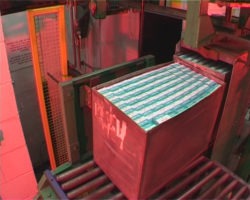When using a surgical blade for an operation, whether on a person or an animal, the sterility of the product is extremely important. But how much do you know about the sterilization process and the steps taken by manufacturers to ensure a sterile product?
Here’s a little insight into the process we use on all of our sterile blades, whether carbon or stainless.
 Cincinnati Surgical, Swann Morton and Lance sterile blades all go through in-house Cobalt 60 Irradiation Sterilization.
Cincinnati Surgical, Swann Morton and Lance sterile blades all go through in-house Cobalt 60 Irradiation Sterilization.
The radiation dose received by a product passing through a Cobalt 60 irradiation facility is defined by five parameters:
- The strength (activity) of the source
- The density of the product
- The time of exposure
- The distance of the product from the source
- The density of any product between the source and the product in question
The control method used at our Sheffield, England facility is based on both time of exposure and the load scheduling of products with different density.
Product is moved through the irradiation facility by product carriers suspended from an overhead conveyor rail. The Cobalt 60 source is enclosed by a concrete shield approximately six and a half feet thick and constructed from high density poured concrete extending to all sides, above and below the source and the product being irradiated.
To monitor the level of sterilization red Perspex dosimeters are attached to products being irradiated on a routine basis to ensure that the process is fully under control at all times. Each batch of dosimeters is calibrated by the National Physical Laboratory.
We are certified to ISO 13485.
View our certificate. Our facility is also routinely inspected by the FDA.
Looking for more information on the sterilization process? Watch the
Discovery Channel’s “How Scalpels are Made” to see the sterilization process in action as well as the other steps taken to ensure the surgical blade you are using is of the highest quality possible.
 Cincinnati Surgical, Swann Morton and Lance sterile blades all go through in-house Cobalt 60 Irradiation Sterilization.
Cincinnati Surgical, Swann Morton and Lance sterile blades all go through in-house Cobalt 60 Irradiation Sterilization.

Recent Comments